Kidney Pain
Last reviewed by Dr. Raj MD on January 12th, 2022.
The kidney is part of the renal system, it helps to eliminate waste and excessive fluids from your body. If there are issues with the kidney then the pain can be unbearable.
In this article, you will learn a bit more about the anatomy and physiology of the kidney as well as possible causes, symptoms, and treatments for the pain from kidney issues.
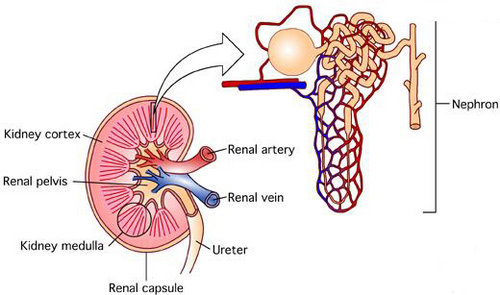
Figure 1 : The complexity of the kidney is extensive and this image is able to break it down into the basic parts.
Picture Source : www.kidneycoach.com
Kidney Anatomy and Physiology
Functions:
- Remove waste and excess fluid
- Hormone production which controls blood pressure
- Production of red blood cells
- Influence and regulation of acid, calcium, potassium and other electrolyte balance (1)
Kidney Location
- The kidney is located along the back wall of the abdominal cavity.
- Usually the kidney on the left side is a bit higher due to the liver position.
- The kidney is not inside the peritoneum lining which is why it is called a retroperitoneal organ.
- The a small amount of fatty tissue, muscles of the back and the ribs form a sort of protection for the kidneys.
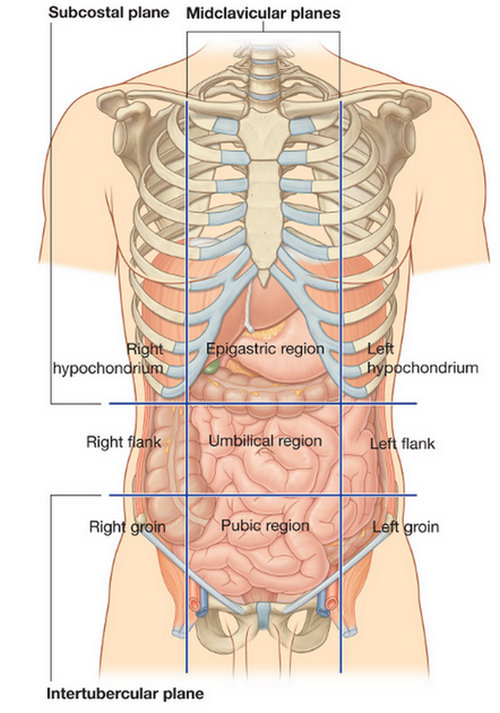
Image: 2 – This image was chosen so that you can imagine the anatomical areas of the frontal section of the body. As you can see here the right and left flank areas is noted alongside the umbilical region. Although you can not see the kidneys in this photo it was chosen so you can also see why the differential diagnosis is so important. The kidneys are not the only organ found in and near the flank area.
Photo Source : web.duke.edu

Picture : Kidney location
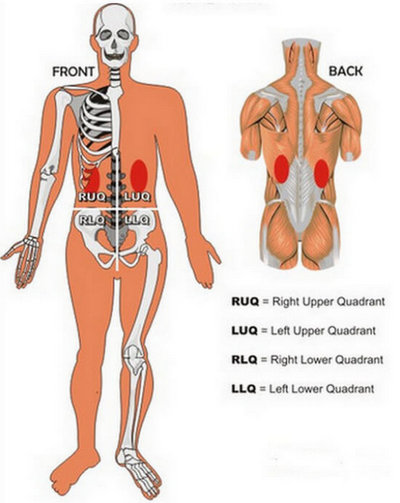
Picture : Kidney location (Anatomy)
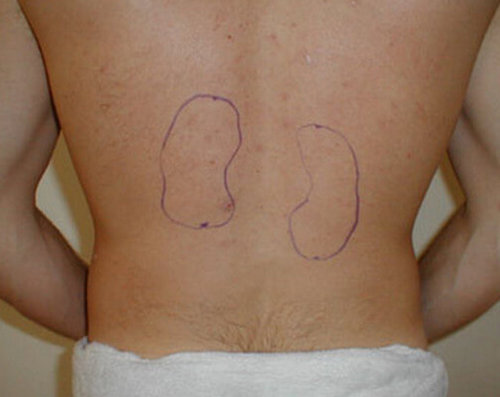
Picture : Surface marking of kidney location
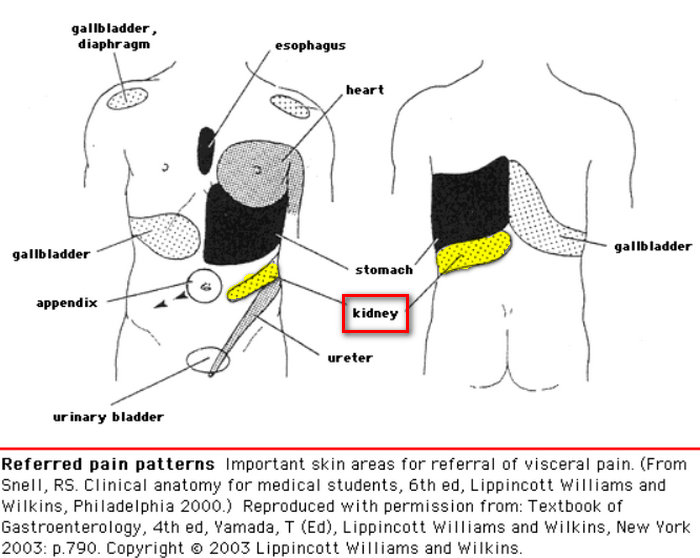
Picture : Kidney pain – with skin areas for referral of visceral pain – highlighted in yellow
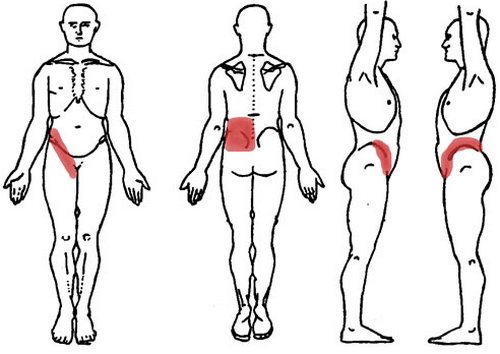
Image 3: This image was chosen so you can see the anatomical areas without the organs. Sometimes it is difficult to imagine the outside of the body when looking at all the organs. In this image you can see very clearly that the flank area is just above the hips and groin area. It only slightly enters where the ribs are located.
Picture Source : www.lower-back-pain-toolkit.com
Associated Symptoms of Kidney Pain may include:
- Fever
- Pain during urination
- Flank pain- pain in the middle back near the sides. Can be noted on either the right or the left side.

Image 4 : A clear depiction of where the flank pain is represented.
Photo Source : aos.iacpublishinglabs.com
Also …
- Pain may be dull or sharp and could radiate down to the pelvic area.
- Vomiting
- Nausea
- Bad breath
- Bad taste in the mouth (metallic)
- Shortness of breath
- Swelling in the extremities. (1,3)
What does kidney pain feel like ?
| Diagnosis | Kidney stones | Kidney infection | Kidney cysts |
| Pain location | Starts as a dull pain and continues to be a sharp stinging or burning pain as the stones move. This pain will come and go in waves | Remains as a dull ache and is usually confused with back pain. | If pain is noticed it will remain dull and usually be accompanied by bloody urine. |
Specific Symptoms of Kidney stones:
Kidney stones are created by extra salts and minerals getting stuck together in the process of making urine. They can be tiny and not even noticeable but when they are large they can cause a lot of pain.
If the stone is small enough the stone can be passed at home. If the pain is too intense you should seek out your doctor.
Specific treatment:
- Water
- Pain medications
- Shock wave treatment- the idea of this treatment is to break up larger stones so they will pass easier.
- Ureteroscopy- This is when they enter the urethra with a tube containing a clamp which will grab and remove the stones.
Specific Symptoms are:
- Blood in urine
- Pain during urination in the back.
- Severe back or groin pain
- Vomiting
- Nausea
You can help prevent kidney stones by not eating excessive amounts of protein or sodium. Also chocolate and dark green vegetables can cause issues. Lastly always be sure to drink plenty of water. (11, 12, 13, 14)
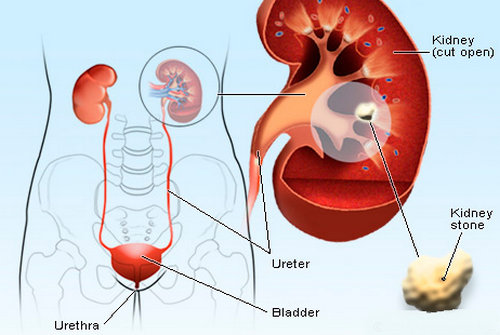
Picture 5 : Where the kidney stone is created and how far it has to pass.
Image Source : images.medicinenet.com
Specific Symptoms and causes of Kidney infection:
A kidney infection is when a urinary tract infection has gone on too long and begins to enter the kidneys. This is called pyelonephritis.
Bacteria enter the urethra from the skin and then climb up into the bladder causing the initial infection. Because the urethra is shorter in women this is much more common in females than males.
This infection can be very serious because it has the possibility to spread into the blood stream.
Symptoms consist of all those mentioned above plus:
- Fever and chills
- Confusion in the elderly.
- Blood in the urine
- Cloudy or foul-smelling urine
- Pain during urination
- Inability to hold the urine
Specific causes
- Prostatic hypertrophy
- Pelvic or abdominal mass
- Bladder stones
Specific treatment
- Antibiotics
When to see your doctor:
- If you note blood in your urine
- Painful urination
- Not feeling better after first few days of antibiotic therapy. (5,6, 8, 9)
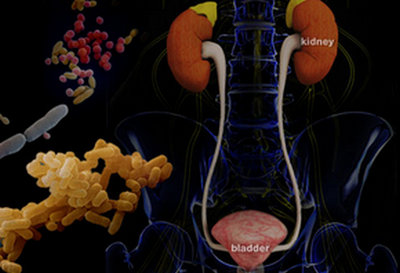
Figure 6 : The different bacteria that can invade the urinary tract to eventually cause kidney infections.
Photo Source : img.webmd.com
Specific Symptoms of Kidney cyst:
A cyst is a pouch of skin filled with liquid. Cysts may form in the kidneys and sometimes do not cause any symptoms. Some of the symptoms that it can cause:
- Side or back pain
- If they get infected you will have fever and chills.
- You may have kidney function issues.
If there are no symptoms you will not need treatment, but if the cyst is causing issues you will need to have the cyst drained. This is done with ultrasound guidance and only done by medical professionals.

Image 7 : Here you can clearly see the liquid filled pouches on the kidney surface.
Picture Source : www.mayoclinic.org
Differential Diagnosis?
Testing must be done to start the differential diagnosis these tests may include and are not limited to the following:
- Physical examination including palpitation of the back. (palpitation is touching with light pressure)
- Blood testing for pregnancy and basic urine exams
- MRI and CT scans may be done to the abdominal area and the pelvic area. (1)
Those tests are done to rule out the following diagnosis:
- Muscle pain in the back or pelvic area
- Spinal issues such as fractures
- Fractured rib
- Punctures to the lung
- Shingles(1,2, 5,6)
Kidney Pain Treatment:
This will greatly be determined by the actual diagnosis decided on. It may consist of:
- Pain medications
- Antibiotics
- Surgery for kidney stone removal if not passed naturally. (1,4)
Possible causes for kidney pain:
- As mentioned above usually the causes are:
- Kidney infection
- Kidney cyst
- Kidney stones
Other causes could be:
- Blunt trauma
- Hemorrhage in the kidneys (excessive bleeding)
- Renal thrombosis (blood clots in the kidney)
- Urine back up (hydronephrosis)
- Cancer in the kidneys
- Horseshoe kidney (both kidneys connected)
- Atherosclerosis in the renal vascular system
- Arteriosclerosis in the renal vascular system(1,2,3,4)
References:
- http://www.medicinenet.com/kidney_pain/article.htm
- http://www.mayoclinic.org/symptoms/kidney-pain/basics/definition/sym-20050902
- https://www.healthdirect.gov.au/kidney-pain
- http://www.kidneyfund.org/kidney-disease/kidney-problems/kidney-pain.html?referrer=https://www.google.com.mx/
- http://www.webmd.com/a-to-z-guides/kidney-infections-symptoms-and-treatments#1
- http://www.nhs.uk/conditions/Kidney-infection/Pages/Introduction.aspx
- http://www.webmd.com/a-to-z-guides/kidney-infections-symptoms-and-treatments#1
- http://www.mayoclinic.org/diseases-conditions/kidney-infection/basics/definition/con-20032448
- https://www.niddk.nih.gov/health-information/kidney-disease/kidney-infection-pyelonephritis
- http://www.urologyhealth.org/urologic-conditions/kidney-(renal)-infection-pyelonephritis
- http://www.webmd.com/kidney-stones/ss/slideshow-kidney-stones-overview
- https://www.niddk.nih.gov/health-information/urologic-diseases/kidney-stones
- http://www.urologyhealth.org/urologic-conditions/kidney-stones
- http://www.mayoclinic.org/diseases-conditions/kidney-cysts/basics/definition/con-20035205
- http://www.webmd.com/a-to-z-guides/kidney-cyst-causes-symptoms-treatments
- https://www.niddk.nih.gov/health-information/kidney-disease/simple-kidney-cysts
- https://medlineplus.gov/kidneycysts.html